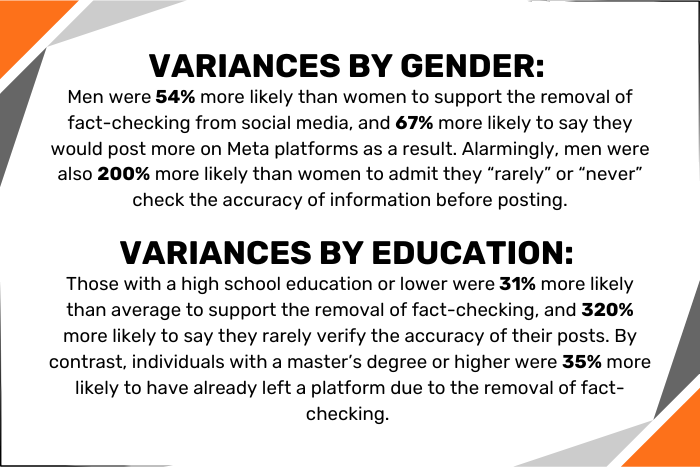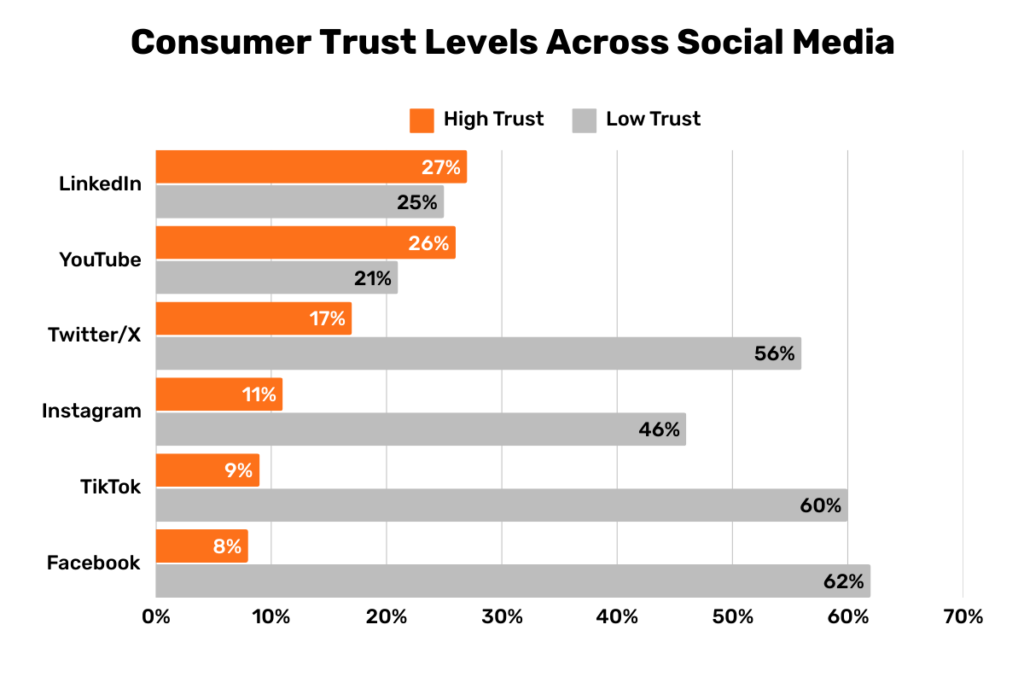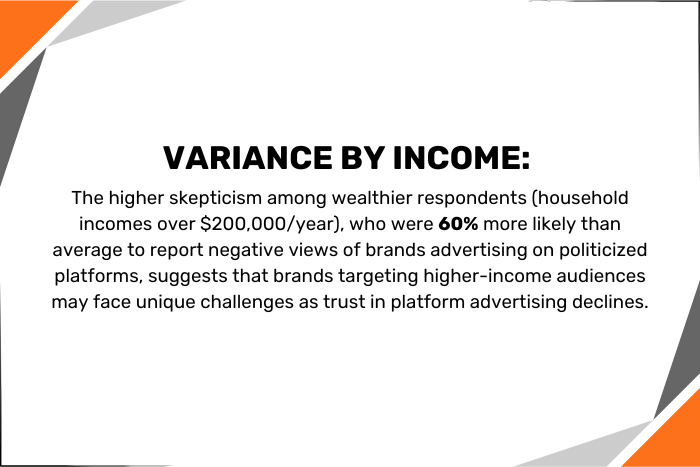
by Nycole Walsh
Social media platforms have evolved from digital gathering places to influential players in the global political landscape. Their decisions about fact-checking, data privacy, and political affiliations now ripple far beyond user experience, influencing public opinion and the brands that rely on these platforms for engagement. As platforms like Meta, TikTok, and X increasingly align with political ideologies and engage in policymaking, they are reshaping consumer trust and the digital advertising ecosystem.
From changes in fact-checking policies to evolving privacy practices, these shifts are changing how consumers interact with platforms—and the brands that rely on them. But are consumers paying attention? And will these developments alter their habits in ways that marketers and sales leaders must prepare for?
Here’s what the latest data reveals, and why it matters for those looking to succeed in 2025.
Fact-Checking: Polarization in Consumer Opinions
Fact-checking has become a flashpoint for consumers. Originally introduced to combat the spread of misinformation and uphold the credibility of online discourse, fact-checking emerged as a response to growing concerns about the rapid proliferation of false narratives on social media. While the practice was initially welcomed as a safeguard for truth, it has since become a polarizing issue. Among respondents:
- 57% opposed the removal of fact-checking, while only 16% supported it.
- Over one-third (37%) of respondents said the removal of fact-checking from social media platforms makes them less likely to keep a profile, but 46% said it would have no effect on their likelihood to maintain a social media presence.

Political alignment also played a major role. Republicans were a staggering 933% more likely than Democrats to support the removal of fact-checking, underscoring a stark ideological divide.
Operating in an environment where misinformation can spread more easily, especially among demographics less inclined to verify their content, is a high-stakes game. However, it presents GTM leaders with an opportunity to differentiate by committing to accuracy, authenticity, and thoughtful engagement. It enables them to earn trust in an increasingly divided and complex digital landscape.
But they must nevertheless proceed with caution: the messaging they share should always align with trusted sources and emphasize accuracy to maintain credibility.
Trust Takes a Hit with Automation
Trust in social media platforms is already low, but automated practices like “forced follows” only exacerbate the issue.
A notable example occurred during the recent transition of the Trump administration, when numerous Facebook and Instagram users reported that their accounts had automatically followed the official profiles of the new President and First Lady. This process, explained by Meta as part of the standard transition of official accounts, caused frustration among users who found themselves repeatedly re-following these accounts even after manually unfollowing them. The incident highlighted ongoing concerns about user autonomy and transparency in platform operations, further intensifying distrust among consumers:
- 79% of Americans said they do not like social media platforms following accounts on their behalf, with nearly half (47%) saying they “hate it.”
- 8 in 10 said that finding out a platform had followed an account without their consent would make them trust the platform less; additionally, nearly three-quarters (74%) said they would trust the followed account or profile less.
- 77% would consider leaving a social media platform if they found out it had auto-followed accounts for them.
Interestingly, Gen Z stood out as an outlier, being 100% more likely than average to say they “like” automated follows. This variance suggests opportunities for experimentation with younger audiences, but brands targeting older generations or broader segments should tread carefully.
TikTok and the Politics of Platform Dependence
TikTok’s journey through U.S. political controversy began with the Trump administration’s efforts to ban the platform over national security concerns related to its Chinese ownership. These efforts culminated in a Supreme Court decision supporting the ban, which led to TikTok’s temporary deactivation in the U.S. in early 2025.
However, just days later, Donald Trump signaled his intent to “save” the platform by granting a 75-day extension for TikTok to negotiate a sale or restructuring. This move allowed TikTok to resume operations in the U.S., with the platform issuing messaging that directly credited Trump’s intervention as pivotal in its return.
TikTok’s narrative positioned its continuation as a strategic victory, framing the platform as essential for creativity and free expression.
But do consumers agree?
- Over half (52%) of Americans believe that Donald Trump “saved” TikTok in the United States; but of these respondents, over a third (34%) were unaware of his previous efforts to ban the platform.
- 35% of respondents expressed negative sentiments about TikTok’s messaging crediting Donald Trump for preserving the platform in the US, with 20% saying they “hated it;” meanwhile, 28% received the messaging positively, with 14% saying they “loved it.”
- The platform’s messaging resonated particularly poorly with women and respondents who identified themselves as being of East Asian descent, who were 71% and 130% more likely than average, respectively, to say they “hated” TikTok’s messaging in response to the upheaval.
- 28% of TikTok users say their usage of the platform will decrease following the events around the platform’s deactivation and subsequent reactivation; however, 62% don’t anticipate any change to their current habits.
The sudden deactivation and reactivation of TikTok underscore the risks of over-reliance on a single platform. Many marketers who had focused heavily on TikTok as a primary channel were left scrambling for alternatives, illustrating how national events can have immediate and industry-specific impacts. Diversification of channels is not just a safeguard against such disruptions; but also a strategic imperative to ensure resilience in an unpredictable digital landscape.
For marketers and sales leaders, maintaining a presence across multiple platforms mitigates the risks of platform-specific challenges and helps their campaigns reach larger, more diverse audiences. While understanding TikTok’s polarizing dynamics remains critical, a balanced channel strategy is key to navigating an environment where political and social forces continually change the playing field.
Privacy Settings and Political Concerns
Interactions between platforms like Meta, TikTok, and X/Twitter and the Trump administration are not only shifting consumer behaviors; they’re also impacting perceptions of trust and control over personal data. Two in three respondents have either changed or are considering changing their privacy settings due to these political ties, highlighting growing concerns over how platforms align themselves with political entities.
- 59% of Americans say they are concerned about interactions between platforms like Meta and Twitter/X and the new administration, with 37% saying they’re “extremely concerned.”
- 20% say they have already changed their privacy settings on certain social media accounts due to these concerns, with another 46% saying they’re considering it.
- 14% have left certain social media platforms entirely due to these concerns, with Facebook (72%) and Instagram (62%) emerging as the most commonly departed platforms.
Trust in individual platforms also varies widely. LinkedIn emerged as the most trusted platform, with 27% of respondents expressing high trust in its content. By contrast, platforms like Facebook and TikTok struggled significantly, with 62% and 60% of respondents, respectively, expressing low trust.

These trust disparities significantly influence consumer attitudes and behavior. 79% of respondents said they’re less likely to use social platforms that appear politically affiliated, and 86% reported being less likely to trust information on such platforms. These numbers underscore how political entanglements erode consumer confidence and, by extension, the effectiveness of ads and messaging brands deploy on these platforms.
These shifts emphasize the need for brands to balance precision in targeted advertising with transparent data practices. Ensuring users feel confident in how their data is being used isn’t just a compliance measure—it’s key to maintaining trust and engagement. Addressing privacy concerns directly in messaging and proactively educating audiences about secure data handling can position brands as allies in a climate where skepticism is on the rise.
More broadly, the interplay between politics, privacy, and platform trust raises critical questions for advertisers: How do these dynamics impact ad effectiveness? Will consumers begin to opt out of sharing data altogether, leading to less personalization and diminished ad performance?
The Impact on Brands
The shifting political landscape of social media platforms isn’t just altering how consumers view the platforms themselves, but also the brands that choose to advertise on them:
- 79% of Americans believe they can influence social media advertising revenue by adjusting their personal privacy settings.
- 75% of Americans who previously shared their data for personalized ads on social platforms say they will no longer do so. Among them, 95% cite privacy concerns, while 37% intentionally aim to impact platform ad revenue.
- When asked about recent interactions between platform leadership and political entities, 64% of respondents said their opinion of brands advertising on those platforms would not change. However, a significant 30% said their opinion would worsen.
The fact that 3 in 10 Americans say their opinion of brands advertising on politicized platforms would worsen underscores a critical challenge for marketers: reputational risks that could directly influence brand perception. This statistic highlights a growing expectation for brands to carefully evaluate their advertising strategies to avoid unintended associations with divisive platforms. By understanding these consumer sentiments and where they diverge, marketers can better anticipate and navigate the complex landscape of consumer expectations.

Key Takeaways for GTM Leaders
1. Understand the Shifting Trust Landscape:
Trust in social media platforms varies widely, with significant disparities based on platform reputation, demographic factors, and political alignment. Go-to-market professionals must recognize these dynamics to effectively tailor their strategies on a channel-by-channel basis.
2. Anticipate Consumer-Driven Revenue Impacts:
With 79% of Americans believing they can influence social media advertising revenue through their privacy settings, platforms and advertisers alike face increasing pressure to adapt to privacy-conscious consumer behaviors.
3. Monitor Reputational Risks:
Declining trust in platforms like Facebook and TikTok could consequently be directed towards brands advertising there, particularly among high-income demographics who express heightened skepticism.
4. Diversify Your Channel Strategy:
The TikTok deactivation highlighted the risks of over-reliance on a single platform. A multi-channel approach ensures resilience and flexibility in the face of unforeseen disruptions.
5. Balance Personalization and Privacy:
As 75% of respondents reconsider sharing data for personalized ads due to privacy concerns, brands must reassess how they deliver value while respecting consumer boundaries.
By embracing these takeaways, GTM professionals can navigate the challenges posed by the politicization of social platforms while positioning their brands to build trust, adapt to shifting consumer behaviors, and thrive in unpredictable times.
Don’t Go It Alone
The evolving intersection of politics, privacy, and platform trust demands a thoughtful approach to marketing and advertising. At Kickstand, we specialize in helping brands turn complex challenges into actionable strategies that build trust and drive results. Whether it’s crafting data-driven campaigns, navigating platform dynamics, or amplifying your voice in a crowded marketplace, we’re here to help.
Contact us today to explore how we can support your go-to-market goals in 2025 and beyond.
Methodology
This report is based on a survey conducted online from January 21–22, 2025, with 627 American adults. The study was conducted at a 95% confidence level, with a margin of error of +/- 3.9%.
Respondents were segmented by key demographics frequently referenced in this report:
- Gender: 44% male, 55% female, 1% non-binary/prefer not to say.
- Political Affiliation: 37% Democrat, 33% Republican, 26% Independent, 4% other/prefer not to say.
- Race/Ethnicity: 60% White, 14% Black or African American, 12% Hispanic or Latino, 8% Asian, 6% other/prefer not to say.
- Generations: 18% Gen Z (ages 18–27), 27% Millennials (ages 28–43), 33% Gen X (ages 44–59), 22% Baby Boomers (ages 60-78).
- Level of Education: 13% high school or lower, 50% Associates or Bachelor degree, 20% Masters or higher, 17% other or prefer not to say



